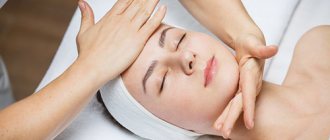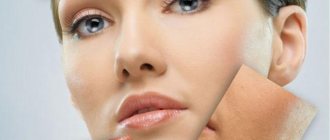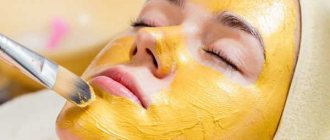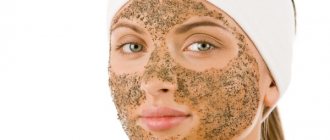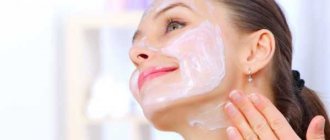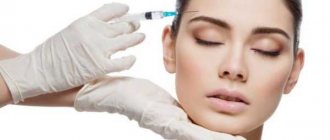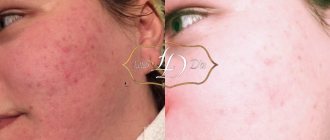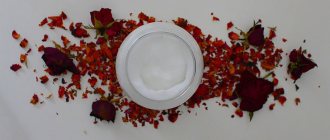Under normal conditions, the skin renews itself every 15–30 days. With age (after thirty) or in the presence of certain diseases (diabetes, ichthyosis, psoriasis, endocrine disorders, keratoderma), this process slows down or even stops. The result is dehydrated skin, rashes, age spots and other cosmetic problems. To remove dead cells from the top layer of skin, we recommend taking a peeling course. The procedure is performed by a cosmetologist who has undergone specialized training—it is prohibited to do peeling yourself.
There are many types of peeling, but they all have one task - removing the stratum corneum of the skin. And the effects from them are approximately the same: rejuvenation, tone and softness, removal of age-related hyperpigmentation and freckles, acne scars, unevenness after demodicosis and hyperkeratosis, reduction of dry skin, treatment of ichthyosis. Each type of peeling also has predominant effects - they were mentioned in the description of the procedures.
We tell you about the five most effective procedures this season. Among them are new products that have become a breakthrough in cosmetology, as well as methods that have long won the hearts of cosmetologists and their clients.
PRX-T33
PRX-T33 is a medium chemical peel, patented after 10 years of clinical research. This product revolutionized cosmetology - scientists for the first time managed to achieve the production of fibroblasts (connective tissue cells) without damaging the top layer of skin.
The main advantage of PRX-T33 is the absence of a rehabilitation period and instant results. This means that after the procedure the skin does not peel or redden, so this procedure can be performed immediately before an important event to refresh the face.
Effects: skin tightening and whitening, treatment of photoaging, elimination of any age spots.
Ingredients: TCA trichloroacetic acid 33% (stimulates the production of fibroblasts), hydrogen peroxide (increases the sensitivity of receptors to TCA), kojic acid 5% (lightens the skin).
On what day after the chemical procedure does the process begin?
You need to understand that the skin will not immediately peel off after peeling. Chemical peeling is essentially a burn, as a result of which the upper layer of the epidermis dies, peels off and in its place new smooth and elastic skin is formed. A certain amount of time must pass before the peeling process begins, usually 2-3 days.
First, the face turns red, then the upper layer of the epidermis begins to crack and only after that the keratinized particles begin to separate, and the intensity of this separation may vary, depending on the following factors:
- Depth of impact. If superficial peeling is performed, there will be no significant reaction - only slight peeling is possible. Medium peeling is accompanied by the detachment of medium-sized flaps of skin.
Deep peeling is carried out only in stationary conditions, and after it there is very strong peeling, which resembles molting.In no case should you peel off peeling pieces yourself or use scrubs to remove them. This can lead to scars and other skin defects.
- The solution that was used during the procedure. The more aggressive the product, the more severe the peeling will be.
- Peeling frequency. If this is the first procedure in many years, and also if the woman has severe hyperkeratosis, peeling may not occur, since the skin in these cases needs more extensive intervention.
We recommend: Peeling after peeling. What to do if the skin is ripped off, and why can’t this be done?
BiorePeel
BiorePeel is a patented medium chemical peel with two-phase technology. This means that in one bottle there are parts: hydrophilic (water) and lipophilic (oil). The first one delicately removes dead cells, the second one restores the skin. Before the procedure, the cosmetologist actively shakes the bottle to mix the parts, then applies the product to the skin.
There is BiorePeel for both the face and body (it helps reduce the appearance of scars and stretch marks).
Effects: revitalization of any areas of the skin, treatment of pigmentation and melanosis, tightening and improvement of complexion.
Ingredients: trichloroacetic, tartaric, citric, salicylic, lactobionic and gamma-aminobutyric acids, as well as arginine, proline, isoproline, sodium ascorbate, riboflavin.
Why doesn’t my face peel off and should this always happen?
So, from all of the above, it becomes clear that peeling after peeling is a normal phenomenon that leads to skin renewal. For what reasons does this not happen?
Not much time has passed
Massive peeling of the epidermis, regardless of the type of peeling, appears only after a couple of days.
In addition, the intensity of exfoliation depends on the concentration of the solution used, so it is best after the manipulation to ask a specialist on what day after the procedure you should expect peeling.
Even before peeling begins, a reaction to the procedure will still be observed. The skin will become tense, it will be unpleasant to touch, and folds will appear during facial expressions. Such phenomena indicate that the procedure was carried out correctly, and peeling will soon begin.
We recommend: How to apply Bepanten and other products after facial peeling? Top 10 creams and ointments
Incorrect concentration
It is possible that your cosmetologist does not have enough experience and prepared the composition in too weak a concentration. But it is quite possible that a gentle composition was specially prepared for a novice client; in this case, this cannot be considered a mistake, just next time the concentration of the solution needs to be increased.
Individual characteristics
There are patients whose skin is resistant to damage to the epidermis. In them, even after aggressive peeling, peeling may not be observed. Also, the skin can get used to the effects of acids - frequent use of tonics, creams and masks with acids. Naturally, in this case the skin reacts much calmer to full peeling.
Gentle procedure
Aesthetic medicine does not imply universal solutions. For each patient, recommendations on the composition of the drug are selected individually and are based on specific indications.
If this is your first time peeling, you will be given a gentle procedure, therefore, the reaction will not be as violent.
In addition, not all peelings involve pronounced peeling:
- gas-liquid;
- carbon;
- vacuum;
- as well as a number of new generation chemical peels.
Carboxytherapy
Carboxytherapy is an unusual two-step procedure.
The first stage is the application of acids, which act as a light peeling (lighten pigmentation, cleanse and tighten pores, even out skin texture).
The second stage is the application of alkali, as a result of which carbon dioxide is released and penetrates into the tissue. The skin feels severe oxygen starvation and triggers a compensatory mechanism (Bohr effect) - the red blood cells of the capillaries begin to intensively release oxygen, blood circulation improves, the supply of nutrients to the tissues increases, the elasticity of the capillary walls improves and stagnation processes decrease.
It just sounds creepy. Carboxyterapia is the best type of peeling for those with hypersensitive, reactive and thin skin. There is no recovery period - the skin does not tighten or peel, there is no burning or redness. You can safely do a one-time peeling before an important event to refresh your face.
Effects: improved skin color, reduced manifestations of rosacea and rosacea, increased blood circulation and reduced congestion.
Ingredients: glycolic, hyaluronic and lactic acids, vitamin C, collagen, vitamins A, E, F, oils, aloe vera.
How to achieve an effect if there is none?
If there is no peeling after peeling, it is recommended:
- Wash your face with thermal or mineral water without gas the next morning after facial peeling.
- Avoid being in the open sun and be sure to apply sunscreen before going outside (even in winter).
- Do not use decorative cosmetics for 3-4 days.
- Do not use thin or exfoliating wipes.
- Apply moisturizer (Panthenol) at night.
Peeling after peeling also depends on the type of skin - the more oily it is, the less peeling. However, it is necessary to carefully choose the salon where the procedure will be performed, as well as a specialist who vouches for the quality and correct concentration of the composition.
Yellow peeling
The official name for this superficial-to-medium chemical peel for the face is retinoic. People call it “yellow” because after the procedure a small layer of yellow remains on the face (this is the first drawback).
The rehabilitation period is quite short (two days), but difficult - the skin peels a lot. Actively moisturize it until the peeling stops.
Effects: reducing the depth of existing wrinkles, scars, smoothing the skin texture.
Ingredients: main component - retinoic acid (vitamin A).
Each manufacturer adds various additional components: vitamin C, azelaic, phytic or kojic acid.
Jessner chemical peel
The essence of the method
The principle of peeling is to artificially activate skin renewal processes by exposing them to acids of varying concentrations, causing a chemical burn of the epidermis.
As a result, the old epithelium dies and peels off and a new one forms. In addition, water metabolism improves, the production of essential proteins increases, fine wrinkles smooth out, and age spots disappear. The skin becomes moisturized, velvety, tightened, and also acquires a healthy, even color and looks much younger. Proper implementation of Jessner's chemical peeling requires highly qualified and extensive experience from a cosmetologist, as well as the use of high-quality products. We use a wide range of cleansing, therapeutic and restorative products Tebiskin from the Italian company General Topics srl. Innovative peelings Enerpeel are used directly for skin renewal, the unique patented technology of which allows us to achieve high results in skin remodeling with the least degree of trauma, which ultimately reduces the period of treatment by a cosmetologist.
The Scandinavian Health Center has all the resources to successfully carry out cosmetic procedures of any complexity.
What are the contraindications to exfoliation?
Experts do not recommend performing this procedure in the following cases:
- During pregnancy and breastfeeding;
- the patient has thin and particularly sensitive skin on the face, as well as wounds, various types of inflammation, herpes;
- allergic reaction to components of medications;
- the presence of pathologies associated with disruption of the endocrine system (diabetes mellitus) and exacerbation of chronic diseases;
- herpes
- taking isotretinoin
- taking a tetracycline antibiotic
- fresh tan
- deterioration in general health associated with the development of an infectious process in the body.
In addition, peeling is prohibited if pharmaceutical preparations containing retinoids - synthetic analogs of vitamin A (retinol), for example Roaccutane, have been used to combat acne for six months.
Technique for the Jessner chemical peel procedure
To get the maximum effect, as well as to avoid possible complications, it is important to carefully follow all the recommendations of the cosmetologist.
Chemical peeling involves intense exposure, so it is necessary to first “prepare” the skin for the effects of acids: carry out special home preparation - pre-peeling. The specialist prescribes to the patient a drug containing glycolic acid with a concentration of 8-10% for regular application to the facial skin. Thanks to pre-peeling, the stratum corneum of the epidermis is softened and the components penetrate uniformly and deeply during peeling. 1 day before the scheduled procedure, you should avoid using tonic.
At an appointment with a cosmetologist, the face is cleaned with a special product that has a degreasing and exfoliating effect. After the preparatory manipulations, an exfoliant (peeling agent) is applied using a disposable applicator. Its composition and concentration of acids is determined by a specialist, taking into account the individual characteristics of the patient, as well as the type and condition of the skin. Exposure duration ranges from 3 to 7 minutes. In this case, the patient may experience a slight tingling or burning sensation. Then a special napkin is used to remove and neutralize the remaining drug. The final stage of the procedure is the application of a softening emulsion and sunscreen (SPF 50).
Recommendations for facial skin care during the rehabilitation period
The next day after chemical peeling, skin redness, tightness, and peeling are observed. The result largely depends on compliance with the following rules:
- Do not wash your face for 12 hours after the procedure;
- use only cosmetic products prescribed by a doctor;
- Do not under any circumstances remove crusts that have formed on the face;
- You should wash your face with slightly warm water, making light and smooth movements;
- try to avoid exposure to UV rays for 2-3 weeks, and before going outside, be sure to apply sunscreen (SPF 50);
- It is prohibited to visit the solarium, sauna, bathhouse and swimming pool.
If all the above requirements are met, an excellent result after 5 to 7 days of the recovery period is guaranteed: beautiful, healthy and elastic skin!
Request a call back
Daily care
Cleansing
To remove makeup and daily cleanse combination skin, it is recommended to use products with a delicate consistency: gels, mousses, foams. They should not contain oils, alcohol, lanolin and butyl stearate. It is better to choose products with a calming effect on a plant basis: with chamomile, aloe, tea tree.
Important rule! Do not rub your face intensively. This injures the skin.
Toning
Facial toner should not be underestimated! It evens out the pH balance of the skin after washing, creates a protective hydrolipid film, and improves microcirculation in skin cells.
Toning is an important stage of care. Combination and aging skin will benefit from a mattifying toner containing panthenol, glycerin and vitamins.
Important rule! The tonic is not intended for removing makeup or cleansing the face. It is applied to clean skin.
Nutrition and hydration
Combination skin after 30 years needs a constant source of nutrition and hydration. Choose rulers that suit your age and skin type. Proper care involves using cream and serum at least twice a day. Their task is to simultaneously satisfy the needs of both oily and dry skin areas.
You should choose products that include:
- hyaluronic acid,
- vitamins and antioxidants,
- lipid replenishing essences,
- soothing herbal ingredients,
- panthenol.
Important rule ! You cannot use only night or only day care products. They have different purposes: daytime ones primarily protect against the negative effects of the environment, nighttime ones intensively care for the skin.
Five “NO’s” in caring for combination skin
For those with combination skin, the following is prohibited:
- Fatty creams and heavy oils (clog enlarged pores).
- Lotions containing alcohol (dry the skin).
- Scrubs more than once a week (injures dry areas).
- Washing with hot water (causes redness and irritation).
- Washing with soap (dries the skin).
Peeling protocol
Stage I. Pre-peeling preparation
For 14–21 days, the patient should apply Prepeel Active to the skin previously cleansed with Cleanser Mousse at night. In the morning, apply MediScreen sunscreen.
Stage II. Chemical peeling
1 step. Cleansing. Apply Cleanser Mousse to the skin of the face, distribute with light massage movements and leave for 15-20 seconds. Rinse with water. Dry the skin.
Step 2. Degrease the skin with Prepeel Lotion.
Step 3. Apply TCAPEEL peeling material using a gauze napkin or a cotton swab to the skin of the face in the direction from the periphery to the center in the following sequence: forehead, temples, cheeks, nose, chin, eyelids. There is a burning sensation and pain. A “frost effect” appears on the surface of the skin. By its intensity, one can judge the depth of penetration, and by its uniformity, one can judge the uniformity of application of the material to all treated areas. If applied unevenly to individual areas, they can be re-treated with the material. The number of layers applied depends on the concentration of the material used (15% or 25%), as well as on the desired penetration depth. Wait 2-3 minutes between repeated applications. There is no need to achieve a pronounced “frost effect” on the skin of the neck, décolleté and hands. After stopping the application of the peeling material, the subjective pain sensations stop.
Step 4 After peeling, apply Vegefarma MCP or Thriphalan MCP cream.
Stage III. Post-peeling care
The course of the post-peeling period depends on the depth of the peeling performed. If 1-2 layers of TCAPEEL 15% are characterized by the absence of crusts and the development of the peeling process, which lasts 4-5 days, then after peeling TCAPEEL 25% swelling and severe erythema increase within 24-48 hours after the procedure. Films and crusts form. During this period, the patient should not wet the skin of the face. Films and crusts peel off spontaneously within 7-10 days. It is necessary to warn the patient about the inadmissibility of their forced removal. When using both TCAPEEL 15% and TCAPEEL 25%, from the first day after the peeling procedure until the exfoliation process is completely completed, it is necessary to constantly moisturize the skin with Vegefarma or Thriphalan Balm cream and protect it from ultraviolet radiation in the morning by applying MediScreen sunscreen.
Injection procedures
After 30 years, the skin begins to get tired, the production of collagen, elastin and hyaluronic acid, which are responsible for regeneration, elasticity and hydration of the skin, decreases.
Help is needed to prevent the signs of aging. Creams, masks and serums have a superficial effect. Injections are required to deliver beneficial substances to the middle and deep layers of the skin.
At the age of 30-35 years, cosmetologists recommend adding injection procedures to your care:
- mesotherapy – injections of vitamin cocktails,
- biorevitalization - injections of hyaluronic acid,
- plasmolifting – injections of your own plasma enriched with platelets.
